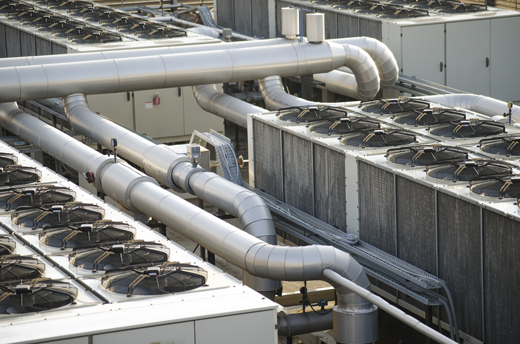

Energy management is a key component in the design of sustainable buildings. Incorporating an energy conservation plan into facility design leads to significant benefits, including:
If you are a facilities manager or a contractor, what are the most effective strategies and practices in heating and cooling design that you can integrate into your building to realize significant energy savings?
Here are a few ideas:
Geothermal heat pumps sometimes referred to as GeoExchange, ground source heat pumps, or water-source systems, are able to heat, cool, and supply buildings with hot water for domestic hot water, underfloor heating and snow melting. Even in areas that experience seasonal temperature extremes, ground temperatures consistently remain between 40 and 80 degrees Fahrenheit.
Geothermal heat pumps will cycle antifreeze solution or water through pipe systems placed underground, or even beneath a body of water. The heat pump uses the temperature of the earth to generate heating and cooling to condition buildings. The ground temperature is warmer than the air above it in the winter and cooler in the summer.
These geothermal systems can reach high efficiencies - 300-600% on the coldest winter nights compared to 175-250% for air-source heat pumps on cold days. Geothermal heat pumps generally return energy savings in 5-10 years.
UFAD systems offer a number of potential advantages when compared to traditional overhead air distribution systems. UFAD systems can increase occupant comfort levels, improve indoor air quality, and reduce energy use.
This is accomplished by using the open space between the structural concrete slab and the underside of a raised access floor system to deliver conditioned air directly into a building, through a variety of supply outlets located at floor level, or as part of furniture and partitions.
Raised floor systems also allow buildings to combine HVAC systems with all major power, voice, and data cabling into one easily-accessible service area. This system could be especially useful in office buildings that employ a significant amount of information technology.
Thermal storage systems can utilize a variety of different technologies and methods to collect excess thermal energy for later use. Depending on the system, thermal energy storage could take the form of converting off-peak electricity to provide heat 24 hour a day, or storing solar energy generated on hot summer days. This energy can be saved for use hours, days, or months after it is stored.
Ice-based technologies can use cheaper electricity to freeze water in the systems chiller at night, and deliver cool air into the building during the day. Other kinds of thermal storage systems include water or ice-slush tanks, rock or earth connected to heat exchangers, reversible pump heat electricity storage systems, and a variety of other methods. These different technologies can help to make buildings operate more sustainably and pass energy savings on to owners.
Energy recovery systems can greatly improve indoor air quality. These ventilation systems can exhaust stale air from a building and use it to treat outdoor air being pulled into the building. The system can exchange heat and energy between the two airflows, pre-cooling and dehumidifying in warmer seasons, and humidifying and pre-heating in cooler seasons.
Depending on the system and building design, energy recovery systems can often provide up 30% more ventilation air than required by code without higher energy costs. Energy recovery systems also can:
Airside economizer systems, commonly referred to as “free cooling,” reduce the load on mechanical cooling systems by utilizing a set of outside and return air dampers that operate together. Exhaust air from indoors is directed outside. If the outside air is too cold, the airside economizers mix the cooler air with exhaust air so temperature and humidity fall within the desired range.
These systems allow buildings to entirely shut off mechanical cooling when outside air temperatures are cold enough, thus reducing the overall energy use of the building.
Peter Basso Associates excels in the sustainable design of high-performance buildings that are functional, energy efficient, and environmentally responsible. In addition to the solutions we covered in this blog, we also specialize in developing other systems that can provide energy savings and reduce operational costs via customized services like our commissioning and retro-commissioning processes and architectural lighting design services.
The best way to help your building achieve and sustain high performance standards is through the commissioning process. Get your free copy of our Building Commissioning Playbook to see what commissioning can do for your building.
These Stories on Energy